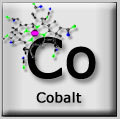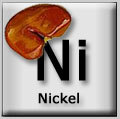Cobalt, Nickel


Cobalt and nickel belong, seen historically, to the first metals with biological significance.
In archaic organisms they have countless catalytical functions, which in the course of evolution were taken over by other metals such as iron, zinc or manganese.
This tendency can be explained by changes in the environment surrounding the organisms. At first, this environment was anaerobic (electron-rich), and became increasingly electron-poor with the formation of atmospheric oxygen. This caused other metal systems to be favored.
Thus, the concentration of nickel and cobalt in some anaerobic bacteria can be quite high. The concentration of both in human serum is below 1 µg/l compared to 100 µg/l for zinc, iron and copper.
The best known cobalt-containing biomolecule is the cofactor of vitamin B12, which contains Co2+ ions in the center of a corrin ring system and is involved in numerous reactions dealing with the formation and degradation of carbon-carbon bonds.
Two nickel atoms are found in the center of urease, which catalyzes the hydrolysis of urea.
